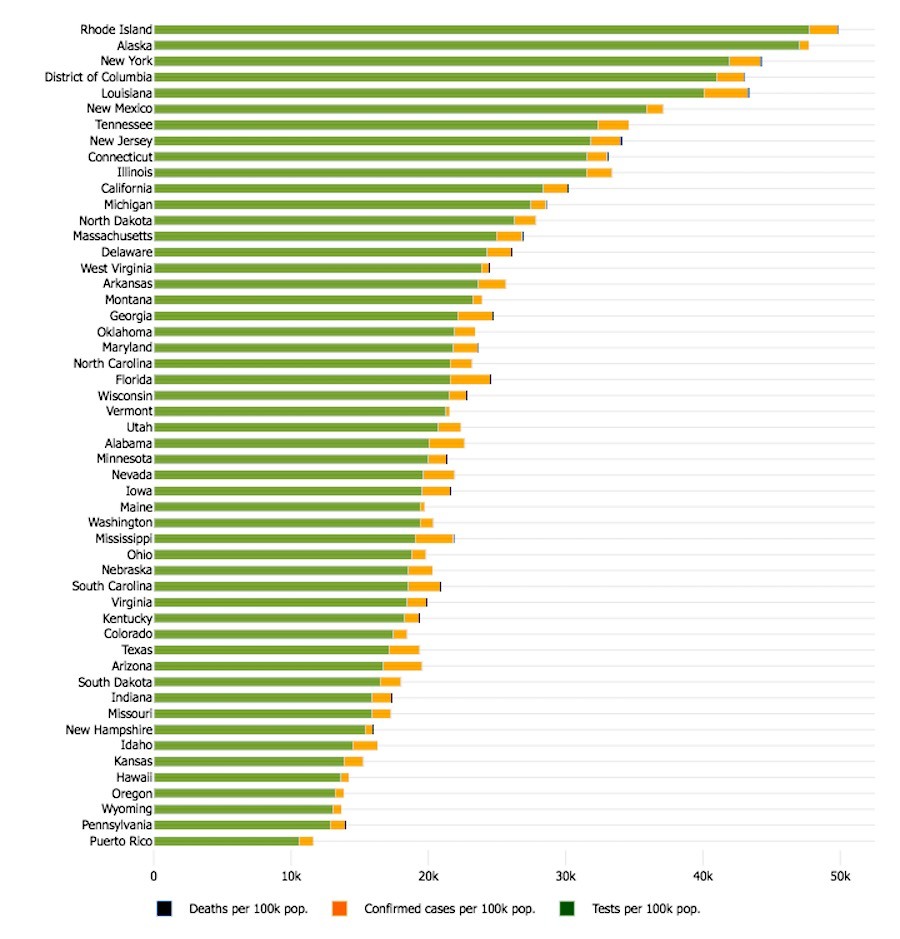Pennsylvania Gives Fewer COVID Tests Per Capita Than Any Other State in the Country
"We are continuing our work to ramp up our testing capacity," says a spokesperson for Pennsylvania Secretary of Health Rachel Levine.

An empty Pennsylvania COVID testing center in a Walmart parking lot in Milford, Pennsylvania, the state with the lowest rate of COVID tests per capita in the United States (Getty Images)
A roundup of Philly news. This article may be updated at any time as new information becomes available.
COVID Testing Per Capita: Pennsylvania Ranks Lowest of the 50 States
According to the latest data from Johns Hopkins Coronavirus Resource Center — pretty much the go-to source for non-politicized COVID-19 information — Pennsylvania gives fewer COVID tests per capita than any other state in the country.
Per 100,000 residents, Pennsylvania has given 12,879 COVID tests, meaning we have tested about 12.9 percent of the population. States at the top of the list include Rhode Island (close to 48 percent), Alaska (about 47 percent), New York (42 percent), Louisiana (40 percent) and New Mexico (36 percent).
As for a state with a similar population and population density to Pennsylvania, Illinois has managed to give COVID tests to about 32 percent of its population. The COVID death rate in Illinois is close to what we are seeing in Pennsylvania. The death rate in high-ranking Alaska is exponentially lower than Pennsylvania’s.
Here’s a look at the latest data for COVID testing per capita in the United States, with Pennsylvania at the bottom of all the states:

A graph visualizing COVID testing per capita in the United States (Johns Hopkins Coronavirus Resource Center)
“By comparing the rate of cases and deaths, we can get a sense of how COVID-19 has affected each state,” says Johns Hopkins in explaining why this COVID-testing-per-capita data is relevant. “Since confirmed case numbers may be dependent on how much testing a state is doing, it is also important to see how many tests have occurred in each state. If people who are infected cannot get tested, they will not be counted as a confirmed case in the state’s data.”
But Nate Wardle, a spokesperson for Pennsylvania Secretary of Health Rachel Levine, says we should expect to see better numbers soon.
“Early on, we faced significant challenges in testing due to the capacity of our testing supplies, coming from the federal government,” Wardle explains. “We now have the supplies needed to test Pennsylvanians who need testing for COVID-19. However, we continue to need those supplies provided to us and our partners across the state to ensure that testing capacity can continue.”
Wardle points out that Pennsylvania has partnered with companies like Rite-Aid, CVS, Quest (via Walmart locations), and Latino Connection, among others, to make sure that COVID testing is available to all Pennsylvanians.
In September alone, says Wardle, the state’s goal is to test an additional five percent of the population, which is about 640,000 people.
“Our testing capacity has went up considerably, to where we are testing nearly 22,500 people a day for the last 30 days,” Wardle insists. “We are continuing our work to ramp up our testing capacity.”
If you’re looking for a COVID test in Philadelphia, here’s everything you need to know.
Is Indoor Dining in Philadelphia “a Recipe for Chaos and Potential Tragedy”?
Indoor dining is set to return to Philadelphia on September 8th — the day after Labor Day. That’s not soon enough for many Philadelphia restaurateurs, most notably the ever vocal Marc Vetri.
But while some cash-strapped restaurateurs and, in some cases, their employees may be happy about this decision, not everyone is. Some restaurateurs have expressed reluctance about reopening indoor dining while the city limits capacity to 25 percent. The math just doesn’t work.
Beyond that, I can tell you first-hand as somebody who has dined indoor in the suburbs, where you’ve been allowed to eat inside at 25 percent for several weeks, that the vibe seriously suffers when the normally packed room is relatively empty and your server is gloved, face-shielded, and masked. As somebody who used to hate eating outdoors, I’ll happily just take a table outside, even if the inside is open.
For a particularly pointed perspective on the prospect of indoor dining in Philadelphia, read this op-ed by Le Virtu owner Francis Cretarola, who argues that indoor dining is “a recipe for chaos and potential tragedy.”
Speaking of Indoor Dining, New Jersey Beats Philly By a Few Days
If you don’t think that indoor dining is a recipe for chaos and potential tragedy and you’re headed to the Jersey Shore for the unofficial end of summer aka Labor Day weekend, I have good news for you. Governor Phil Murphy has lifted the ban on indoor dining in New Jersey beginning this Friday, September 4th. (FYI: Philly health secretary Thomas Farley said that he chose the day after Labor Day specifically because he didn’t want holiday weekend diners trying to cram into restaurants.)
Like Philadelphia, there is a 25 percent capacity limit on New Jersey indoor dining. But unlike Philadelphia, where there’s a ban on bar seating and on tables of more than four people, New Jersey will allow bar seating and the table limit is eight people.
One note for casino-goers: Buffets are still banned. Thank God.
And Briefly Noted…
- The Main Line invention making your next dental check up safer during COVID
- More Philly restaurants say their final goodbyes thanks to COVID
- And then there are those Philly restaurants that somehow managed to open during COVID


